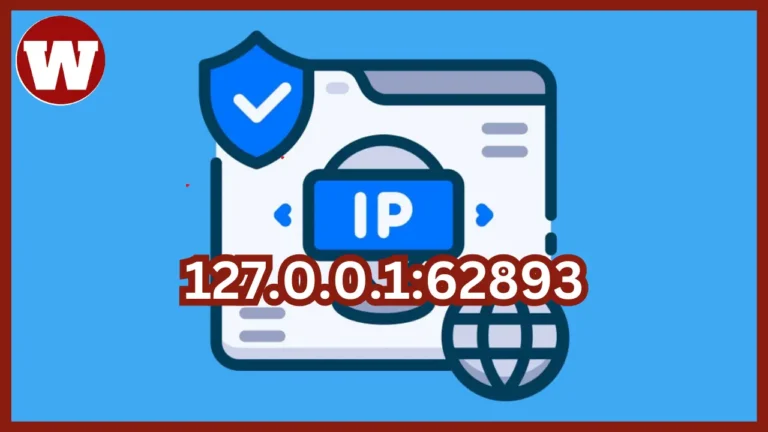In web development, few terms are as crucial yet as frequently misunderstood as 127.0.0.1 and the accompanying port numbers, such as 49342. Whether you’re new to programming or an experienced developer, these terms are foundational to understanding local network communication. 127.0.0.1, also known as localhost, serves as a way for your computer to talk to itself. It’s essential for running local servers, testing applications, and troubleshooting software before moving them to production.
This guide will unravel the nuances of 127.0.0.1:49342, why it’s used, and how developers leverage this combination to enhance their workflow. By diving into the IP address and the port number, we’ll shed light on how this tool plays a pivotal role in local development and beyond.
The Power of 127.0.0.1: Loopback Address Explained
At first glance, 127.0.0.1 might seem like a random string of numbers. However, it plays a crucial role in network communications, specifically as a loopback address. Every device connected to a network is assigned an IP address—a unique identifier allowing machines to communicate with one another. But sometimes, a device must send network requests back to itself to perform certain tests or host services internally.
This is where 127.0.0.1 comes into play. It’s a reserved address that all machines use to route requests to themselves, allowing them to function as both a server and client. Essentially, when your machine sends a request to 127.0.0.1, it’s like calling yourself. It enables your computer to communicate with its network stack, which is crucial for testing, debugging, and running services locally.
This concept is central to developers who need to ensure their code behaves as expected without deploying it to a live environment. For example, before launching a website or app, testing it locally via localhost ensures that any bugs or issues can be identified and fixed without risking exposure to external users or systems.
Diving Deeper Into Ports: The Role of:49342
While 127.0.0.1 specifies that the request should be directed back to your machine, the 49342 denotes a port, which is just as important. In the world of networking, a port is akin to a virtual gateway or door through which different kinds of traffic flow in and out of your system. Each service or application running on your computer requires its port to handle the data it sends and receives.
Ports can range from 0 to 65535, with the first 1024 ports being considered well-known ports. These ports are reserved for standard services—such as 80 for HTTP or 443 for HTTPS traffic. But beyond these standard ports, developers often use higher-numbered ports like 49342 to prevent conflicts with other services running on their machine. These port numbers are often assigned automatically by the system or selected manually by developers.
When a web developer runs a local server, the port number acts as an identifier for the service being tested. For example, you might run a development server for a web app on port 49342, meaning the application can be accessed locally via 127.0.0.1:49342. The beauty of using a high port number is that it reduces the likelihood of clashes with other services or applications that might be using lower-numbered ports.
Why Developers Love 127.0.0.1:49342
There are several compelling reasons developers rely on 127.0.0.1:49342 when building and testing their applications. Let’s take a closer look at some key use cases:
Local Development and Testing: Perhaps the most common reason to use 127.0.0.1:49342 is for local development. Before launching an application to a live server, developers need to run it in a controlled environment. Using 127.0.0.1:49342 allows them to simulate how the application will perform in real-world conditions—without exposing it to the internet. This not only speeds up the development process but also reduces the risk of errors making it into production.
API Development and Mock Servers: Building an API is a complex process that requires rigorous testing. Developers use localhost to test API endpoints, ensuring they return the correct data and handle requests appropriately. Additionally, mock servers are often run locally to simulate external services, allowing developers to verify that their code integrates smoothly with third-party APIs before going live.
Debugging and Troubleshooting: Localhost serves as a safe environment for debugging and troubleshooting. By running an application locally, developers can track down issues without external interference, isolate bugs, and refine their code. The ability to control the entire environment is invaluable for identifying and fixing problems.
Security and Privacy: Running applications locally on 127.0.0.1 adds a layer of privacy and security. Since the application is confined to your machine, it’s not accessible to the outside world, reducing the risk of malicious attacks or unauthorized access. This is especially useful when dealing with sensitive data or unfinished applications.
How Does 127.0.0.1:49342 Work in Real Development?
Imagine you’re working on a new web application. You’ve written most of the backend code, but you need to test whether your app is handling user requests properly. Instead of deploying your app to a live server, you decide to run it locally.
You start a local development server, assigning it to 127.0.0.1 and selecting port 49342. This allows you to view and interact with your application as if it were live, but with one major difference—only you can access it. No one else can see or interact with the app because it’s confined to your local environment.
You open your browser and type 127.0.0.1:49342 in the address bar. Instantly, your web app loads, and you’re able to interact with it in real time. The advantage here is that you can make changes to your code, refresh the page, and immediately see the results. If something goes wrong, you can tweak the code, debug errors, and continue testing without ever leaving your machine.
This setup is crucial for iterative development. Whether you’re building a simple website or a complex API, the ability to test locally allows you to develop faster and with fewer headaches. Once you’re satisfied that everything is working correctly, you can deploy your app to a live server, confident that it will perform as expected.
Extended Use Cases for 127.0.0.1:49342
The concept of using 127.0.0.1:49342 isn’t limited to web development. Here are a few extended scenarios where developers find value in this local setup:
Game Development: Many multiplayer games rely on servers to connect players across the globe. During development, game creators often use localhost addresses to run test servers, allowing them to simulate multiplayer environments without the need for a public server. This enables them to tweak gameplay, improve network performance, and troubleshoot bugs without impacting real players.
Database Management: Database administrators frequently use localhost to manage databases locally. Running a database on 127.0.0.1 ensures that no external parties can access it, providing a secure environment for data manipulation, migration, or troubleshooting. For instance, when working with sensitive datasets, using a local database keeps the data confined to your machine, minimizing the risk of leaks.
IoT Development: The Internet of Things (IoT) relies heavily on networked devices. Developers working on IoT projects often use localhost to test communication between devices before deploying them into the field. Whether they’re working on smart home systems or industrial IoT devices, using 127.0.0.1 ensures that everything runs smoothly on a local network before scaling to larger systems.
Mobile App Testing: Developers building mobile apps can also benefit from local host environments. By running a local server on 127.0.0.1:49342, they can test how their mobile apps interact with backend services without needing to set up a remote server. This accelerates the development cycle and ensures that the app works as intended before it’s launched.
Best Practices for Using 127.0.0.1:49342
While 127.0.0.1 and port numbers like:49342 are incredibly useful, there are a few best practices developers should follow to ensure a smooth experience:
Avoid Overloading Ports: While it’s tempting to assign random ports like 49342, make sure that the ports you’re using aren’t already occupied by other services on your machine. Use tools like Netstat to check which ports are in use and avoid conflicts.
Keep Ports Secure: Even though localhost is private by nature, it’s still a good idea to secure your ports. Use firewalls or other security measures to ensure that no unauthorized applications or users can exploit open ports.
Test Regularly: Don’t just rely on local testing. Once your application works smoothly on 127.0.0.1:49342, push it to a staging environment and run additional tests. This ensures that your app performs well in real-world conditions.
Conclusion
The combination of 127.0.0.1:49342 encapsulates the essence of local development. It provides a practical solution for developers to create, test, and perfect their applications while ensuring security and privacy. Whether you’re a seasoned professional or just starting your coding journey, understanding how to utilize this powerful tool is essential for building robust applications that can stand the test of time.
As we continue to explore new technologies and methodologies, let’s keep the principles of local development at the forefront. Embrace 127.0.0.1:49342 not just as an IP address and port number but as a gateway to creativity, innovation, and the limitless potential of the digital landscape. Happy coding!
FAQs
FAQ 1: What is 127.0.0.1:49342?
Answer: 127.0.0.1 is the loopback IP address, commonly known as localhost. It refers to the local computer or server that you are working on. The number 49342 is a specific port number used for communication between your computer and the application running on that port. Together, 127.0.0.1:49342 allows you to access services or applications that are hosted locally on your machine.
FAQ 2: Why should I use localhost for development?
Answer: Using localhost for development provides a safe and isolated environment to build, test, and debug applications. It eliminates the risks associated with deploying code to a live server and allows for rapid iterations. You can experiment with features without affecting end-users or production data, making it an essential practice for developers.
FAQ 3: How can I access my application running on 127.0.0.1:49342?
Answer: To access an application running on 127.0.0.1:49342, simply open a web browser and enter the URL http://127.0.0.1:49342 or http://localhost:49342. This will direct your browser to the application hosted on that specific port. Ensure that the application is actively running; otherwise, you may receive an error message.
FAQ 4: Can I change the port number for my application?
Answer: Yes, you can change the port number for your application if needed. Most development frameworks and servers allow you to specify a different port when you start the application. Just make sure to update the URL accordingly in your browser to reflect the new port (e.g., http://127.0.0.1:YOUR_NEW_PORT).
FAQ 5: What are some common applications that use 127.0.0.1?
Answer: Several common applications and services run on 127.0.0.1, including web servers like Apache and Nginx, database servers like MySQL and PostgreSQL, and application servers like Node.js. Many development tools and frameworks utilize localhost for local testing and debugging.
FAQ 6: How does using 127.0.0.1:49342 improve security?
Answer: Utilizing 127.0.0.1:49342 improves security by keeping your development environment isolated from the public internet. Since only applications running on your local machine can access this address, it reduces the risk of unauthorized access, making it safer to test and debug applications without exposing sensitive data or code.
FAQ 7: What should I do if I can’t connect to 127.0.0.1:49342?
Answer: If you cannot connect to 127.0.0.1:49342, first check if the application you are trying to access is running on that port. If it’s not, you may need to start the server or check the configuration settings. Additionally, ensure that no firewall or security software is blocking access to that port.
FAQ 8: Is 127.0.0.1:49342 the only way to run applications locally?
Answer: No, 127.0.0.1:49342 is just one example of how to run applications locally. You can use other ports, and different configurations depending on your development environment. Additionally, technologies like Docker can create isolated containers for running applications, further enhancing the local development experience.




